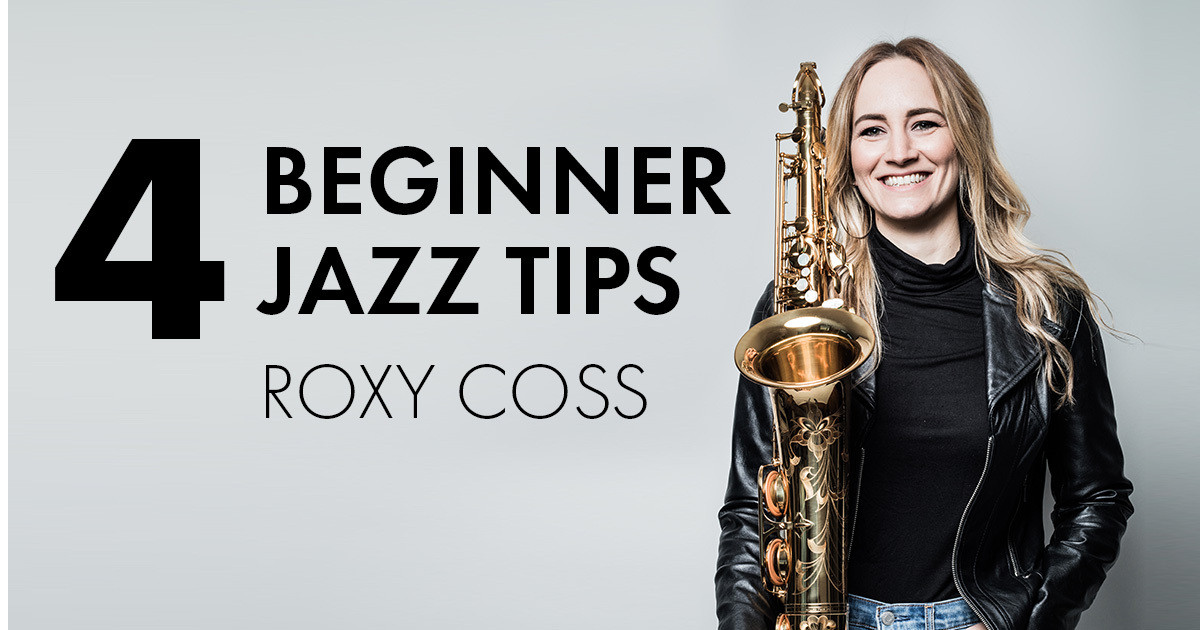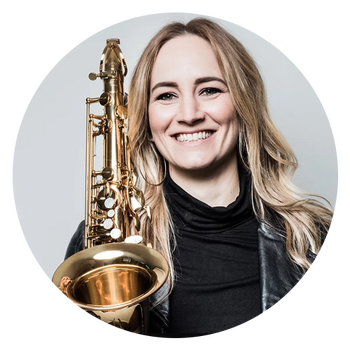4 Key Topics Every Jazz Beginner Should Learn in Their First Lesson
Interview with Roxy Coss
Date Posted: December 21, 2016

WAVE: What methods do you use to teach jazz (and specifically improvisation) to beginners? Theory, tunes, learning by ear?
Jazz
Roxy Coss: As for jazz, I think the most important thing is to introduce students to recordings of jazz that they will connect with, and will inspire them.
If I’m teaching a song, I will try to play a version (or many versions) of the song for the students so they can hear what it can sound like, what feeling it has. I also try to play students a wide variety of jazz recordings, so they can start to listen to jazz on their own terms.
Different students will respond more to different players and styles. You can’t speak a language without hearing it spoken, and a lot of kids don’t grow up listening to jazz. So the most important thing you can do is inspire them to listen, and spark their imagination.
Improvisation
As for improvisation, I use various methods, dependent on the students’ experience and confidence levels, their proficiency level on the instrument, and their knowledge of theory.
In the case of a very beginning and young student, I will have students begin to improvise based on rhythm, and limit them to only one note, two notes, three notes, etc. until they are comfortable enough and confident enough to utilize a full scale or chord. We may exchange phrases, or try to repeat each other’s phrases. Often I will incorporate ear training, as in teaching a blues scale by ear, or playing phrases and asking students to do a Question and Answer approach.
I think there are a few basic skills that greatly help a student begin to learn to improvise on their instrument, in order for them to feel confident, and feel like they are able to grasp a concept fully, and build on it.
"You can’t speak a language without hearing it spoken, and a lot of kids don’t grow up listening to jazz." - Roxy Coss
Major Scales
They need to know a major scale, so they have a context for any harmonic aspects of the material they are to improvise with, and therefore create their own melody.
For instance, if I want them to improvise over a dominant 7 chord, the first step to understanding what notes to use, is based on alterations of the major scale. That being said, a mastery of major scales is a huge part of my expectations for my students.
Basic Rhythms
Students also need to know basic rhythms, so they have some material to choose from when constructing phrases. Hopefully by the time they are learning to improvise, they can at least play eighth notes and mixed rhythms, including syncopation. Again, listening to jazz will help in this regard.
Style
I also try to encourage students to play in the style -‐ most often, I will teach them about swung eighth notes and jazz articulation early on, so that if we are playing something medium swing, their notes sound appropriate to the style.
It’s always frustrating to meet a student who is advanced in theory and technique on their instrument, yet has never been taught how to swing! I like to back it up in these cases, and make sure they understand where jazz rhythms are coming from.
Understand Harmony
The first harmony lessons I try to teach my improv students include key signatures/major scales; major modes; and basic chord definitions -‐ how to construct major, minor, and dominant chords.
The next step is teaching half-diminished, diminished, (and sometimes altered dominant, minor-major, and augmented chords if they are more advanced); the ii-V-I chord progression (iii-VI-ii-V for more advanced); minor ii-V-i chord progression; and modal improvisation (having them play over Dorian, or Mixolydian), or even just blues scale over a blues.
Then I build, having them use multiple scales.
I always try to show them you can think of the notes of the chord arpeggios, or you can think of what scale works over a chord progression.
In different instances, one or the other approach will be easier, or more appropriate. Eventually, I try to get them to understand functional harmony, so they can figure out for themselves which scales to use over which chords, and so they can find the tonality and key center at any given time in a tune. Eventually, the more tunes they learn, the easier it will become.

About Roxy Coss
Musician, Composer, Bandleader, Educator and Activist Roxy Coss has performed around the world, headlining at the Newport Jazz Festival, Melbourne Big Band Festival, NYC Winter JazzFest, BRIC JazzFest, Earshot Jazz Festival, San Jose Jazz Summerfest, Jazz Standard, and Jazz Showcase. A recipient of an ASCAP Young Jazz Composer Award, the Downbeat Critics’ Poll listed her as a "Rising Star" on Soprano Saxophone the past seven years, called her "An exceptional young talent”, and Jazziz Magazine listed her an “Artist to Watch” in 2019. She is also the recipient of the Hothouse Magazine & Jazzmobile “Tenor Saxophone” Award in 2019.
She has performed as a side musician with with Jazz Greats and luminaries including Clark Terry, Billy Kaye, Maurice Hines, Rufus Reid, Louis Hayes, Gene Perla, Houston Person, Claudio Roditi, Bill Charlap, Willie Jones III, Jeremy Pelt, Darcy James Argue, and is a member of the DIVA Jazz Orchestra. Her fifth album as a leader, Quintet (Outside in Music), received a 4-Star review from Downbeat. The Roxy Coss Quintet, featuring some of the world’s finest young musicians, is the first-ever recipient of the Emerging Artist Project, a four-year grant from the Local 802 Musicians Union. Roxy is on the Board of Directors for the Jazz Education Network, is on Jazz Faculty at The Juilliard School, and is the President & Founder of Women In Jazz Organization (WIJO). Roxy is an endorsing Artist for P. Mauriat, Vandoren, and Key Leaves products.